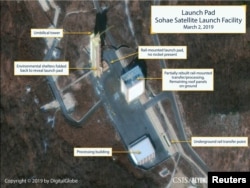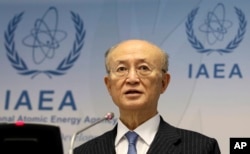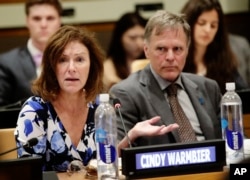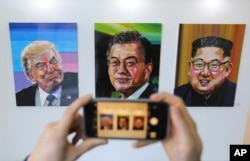U.S. President Donald Trump said Wednesday that he would be "very disappointed" if reports that North Korea was rebuilding a rocket launch site were true.
"I would be very disappointed if that is happening," Trump told reporters in the Oval Office, but he cautioned that it was a "very early report."
Days after he boasted about having a strong relationship with North Korean leader Kim Jong Un, Trump said that if the reports about the launch site proved to be correct, " I would be very, very disappointed in Chairman Kim, and I don't think I will be, but we'll see what happens."
Multiple sources have reported that North Korea has restored part of the launch site it had begun to dismantle, which it pledged to do at the Singapore summit with Trump last year.
38 North, a Washington-based North Korea project, says satellite images depicted structures on the launch pad at the Tongchang-ri launch site, also known as Sohae, had been rebuilt between Feb. 16 and March 2.
Furthermore, South Korea’s Yonhap News said that the country’s National Intelligence Service had told lawmakers the work was taking place and involved replacing a roof and a door at the facility.
The Center for Strategic and International Studies (CSIS) also concluded North Korea was "pursuing a rapid rebuilding.”
The CSIS report added, "Activity is evident at the vertical engine test stand and the launch pad's rail-mounted rocket transfer structure.”
Following the Singapore summit, Trump told reporters that the North Korean leader had promised to destroy a major missile engine testing site.
The president didn’t identify the site at the time, but a U.S. official later told Reuters that the facility was located at Tongchang-ri.
Neither the U.S. State Department, the White House nor South Korea’s Unification Ministry commented on the report about the rebuilding effort. South Korea’s presidential office, the Blue House, had yet to respond to multiple requests for comment.
In addition, International Atomic Energy Agency chief Yukiya Amano revealed in a quarterly report that North Korea’s Yongbyon uranium-enrichment facility remained active.
Amano also stated North Korea was continuing work on building an experimental light-water reactor at the facility.
It was unclear what effect the news surrounding developments at Tongchang-ri and Yongbyon would have on diplomatic efforts with North Korea, but U.S. national security adviser John Bolton said Tuesday that the United States would look at increasing sanctions against Pyongyang if Kim did not end its nuclear weapons program.
Speaking on the Fox Business Network, Bolton said Washington was waiting to see whether Pyongyang was committed to abandoning its "nuclear weapons program and everything associated with it."
"If they're not willing to do it, then I think President Trump has been very clear ... they're not going to get relief from the crushing economic sanctions that have been imposed on them and we'll look at ramping those sanctions up in fact," Bolton said.
U.S. lawmakers, however, aren’t delaying in trying to ramp up sanctions on North Korea.
Tuesday, Republican Sen. Pat Toomey of Pennsylvania and Democrat Chris Van Hollen of Maryland introduced a bill to impose sanctions on any bank that does business with North Korea's government.
The measure had the added endorsement of the parents of Otto Warmbier, the U.S. college student who died after being imprisoned in the reclusive country as a result of the treatment he received during captivity.
Dubbed the "Otto Warmbier Banking Restrictions Involving North Korea (BRINK) Act,” Otto’s parents said they believed the legislation would provide help in eliciting change in North Korea.
"We continue to support the bill and appreciate them honoring our son's memory," the Warmbiers said.
The measure unanimously passed the Senate Banking Committee last year but did not advance further.
To become law, the bill needs to pass both houses of Congress and be signed into law by Trump.
Resumption of talks
South Korean President Moon Jae-in has ordered his cabinet to pursue all avenues to facilitate a resumption of discussions between Washington and Pyongyang.
“We look forward to continuing the dialogue between the two countries, and I expect that the two leaders will meet again in the near future and achieve the settlement this time,” Moon said earlier this week while presiding over a National Security Council meeting.
After the Hanoi summit resulted in no agreement being signed between Trump and Kim, Moon said South Korea’s role had become important, and he directed ministers to act.
Moon said he wanted officials to “confirm the differences in the positions of the two sides” and “look for ways to narrow the gap.”
“I believe that the North American dialogue will eventually be settled, and it’s very undesirable to have a vacuum and deadlocked stage for a long time, so please work hard together for the resumption of the North American dialogue,” Moon said.
He added, “I would like to find out the best ways to help North American dialogue through the development of inter-Korean relations within the framework of sanctions.”
Moon specifically identified projects agreed to during his summits with Kim, including the reopening of the Kaesong Industrial Complex and the resumption of tours to Mount Kumgang.
Speaking Tuesday at the commission ceremony of the Korean Naval Academy, Moon spoke optimistically of the future.
"Should we consistently pursue peace with firm determination, denuclearization of the Korean Peninsula and permanent peace will definitely come," he said.
Lee Ju-hyun contributed to this report.















